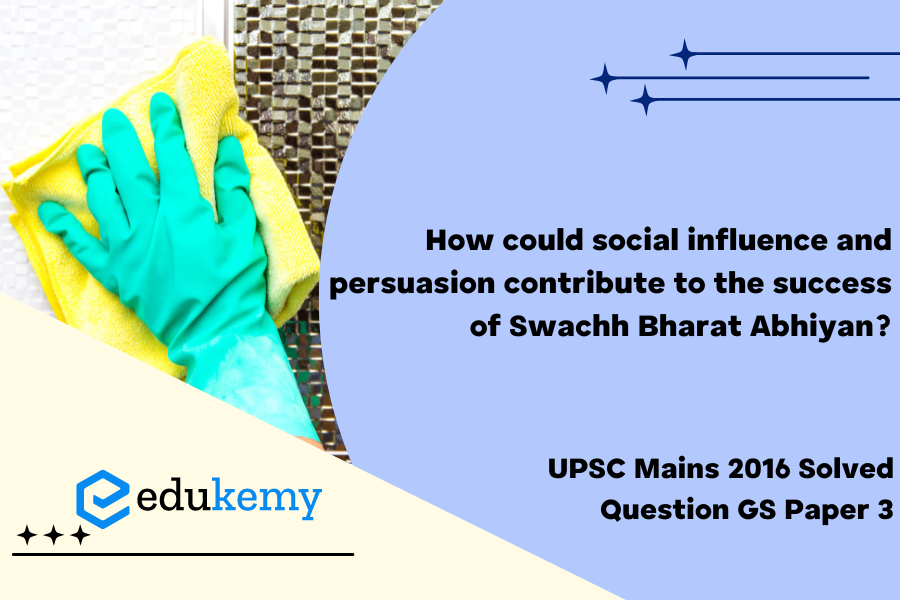Social influence and persuasion play pivotal roles in the success of initiatives like Swachh Bharat Abhiyan, which aims to achieve a cleaner and healthier India. The campaign, launched by the Indian government, relies heavily on altering societal norms and behavior to foster a collective commitment to cleanliness. Social influence comes into play as individuals observe and emulate the positive actions of their peers and community members. Persuasion, on the other hand, involves effectively communicating the benefits of a clean environment, appealing to people’s sense of civic responsibility, and instilling a shared vision for a hygienic nation. By leveraging these psychological mechanisms, Swachh Bharat Abhiyan fosters a sense of social responsibility, encouraging citizens to actively participate in maintaining cleanliness, thereby contributing to the overall success of the campaign and the realization of a cleaner, more sustainable India.
Tag: Attitude: content, structure, function; its influence and relation with thought and behaviour; moral and political attitudes; social influence and persuasion.
Contents
Decoding the Question:
- In the Introduction, try to write a brief introduction about Swachh Bharat Abhiyan and the significant reasons for its success can be attributed to social influence and persuasion.
- In Body, elaborate on how Social Influence and Persuasion Contribute to the Success of Swachh Bharat Abhiyan.
- In Conclusion, try to conclude how the use of social influence and persuasion to the success of SBM has created a blueprint for other programs and schemes.
Answer:
Social influence occurs when one’s emotions, opinions, or behaviors are affected by others in society. It is a broad term that relates to many different phenomena like conformity, obedience, and persuasion.

The Swachh Bharat Mission (SBM) campaign was launched by the Government of India in 2014 to eliminate open defecation and to achieve the goal of open defecation-free India by 2nd Oct 2019. A significant reason for its success has been possible because SBM followed a bottom-up approach to behavior change through social influence and persuasion and a widespread partnership-driven approach to implementation.
Social Influence and Persuasion Contribute to the Success of Swachh Bharat Abhiyan:
- SBM followed a demand-driven approach, as opposed to the supply-driven approach of previous sanitation programs. It focused on use of strong persuasion tools like Information Education and Communication (IEC) and Interpersonal Communication (IPC) strategies to “trigger” the communities through over six-lakh swachhagrahis.
- SBM was about the change in deep cultural and social habits in India regarding toilets and cleanliness. Changing behaviour, beliefs, and myths around toilets is key to ensuring sustained open defecation-free status in all communities across India.
- For this a technique of social influence for behavioral change called community-led total sanitation (CLTS) came in handy. CLTS did not just help to educate but also mobilize villagers’ demand for toilets, better sanitation, and drinking water facilities. It was done by showing them how as long as open defecation continued, they would always be at risk of disease.
- Sanitation marketing refers to efforts focused on social influencing behavior towards sanitation and cleanliness, using some of the techniques employed in commercial marketing. Similar to commercial sector marketers whose objective is to sell goods and services, sanitation marketers’ objective is to successfully influence desired sanitation behaviors. The sanitation marketers are called ‘sanitation motivators’ [or Swachhata Doots / Swachhata Sena] in India.
- Use of Street Theatre Group for social influencing and persuasion: A street theater group was trained to enact street plays with sanitation and cleanliness messages. They generally blend a lot of local jokes and make people laugh at themselves for what they are doing. They make it very much local to tease people and prick people in their conscience.
Persuasive messages via television, radio, Internet or face-to-face communication featuring filmstars, sportspersons, and other celebrities exhorting people to change their habits by explaining the damage of poor personal hygiene, littering, and open defecation to the health of all citizens can go long way in causing a behavioral change. For example, the POSHAN scheme is leveraging the social capital of various grassroots functionaries, volunteers, self -help groups, and swachhagrahis, to bring about behavior change at the grassroots through social influence and persuasion.
In case you still have your doubts, contact us on 9811333901.
For UPSC Prelims Resources, Click here
For Daily Updates and Study Material:
Join our Telegram Channel – Edukemy for IAS
- 1. Learn through Videos – here
- 2. Be Exam Ready by Practicing Daily MCQs – here
- 3. Daily Newsletter – Get all your Current Affairs Covered – here
- 4. Mains Answer Writing Practice – here


